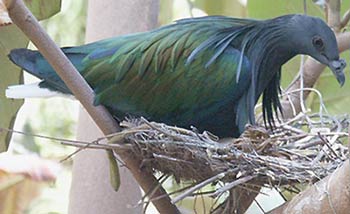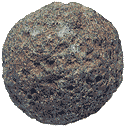
The Nicobar Pigeon - Living relative of the Dodo
Who are the Dodo’s relations?
The contenders for the original parents of the Dodo and the Solitaire were the
Fruit Pigeons (Treronidae) from Madagascar, the Tooth-billed Pigeon
(Didunclus strigirostris) from Samoa, or the Crowned Pigeons (Goura)
from New Guinea.
A team from Oxford University’s Henry Wellcome Ancient Biomolecules Centre, led by its Director, Dr. Alan Cooper, together with scientists from Oxford’s Department of Zoology, and the Natural History Museum, have been examining Dodo tissue found on the head and foot already deposited at the Museum. Painstakingly, they managed to extract sufficient soft tissue from inside a claw of the foot to give a reasonable DNA sample. By doing this, they have been able to build a family tree by testing and comparing the DNA of other birds, which are thought to be related.

The Nicobar Pigeon - Living relative of the Dodo
These scientists have now agreed that the Dodo and the Solitaire's closest living relative is the Nicobar Pigeon (Caloenas nicobarica) which still lives in the Nicobar and Andaman Islands, situated 1300 km (812 miles) east of Sri Lanka, and 5000 km (3125 miles) from Mauritius.
Did the Dodo and the Solitaire fly?
At one time the ancestors of Dodos and Solitaires were able to fly in order
for them to reach their remote islands in the middle of the Indian Ocean. It
seems that they became flightless on Mauritius and Rodrigues, from where they
never escaped.
Why did these birds stop flying? Although most birds make it look easy, flying takes a considerable amount of effort. As they did not have any predators, they found it increasingly unnecessary to fly, especially as they fed on seasonal fruits and other herbage accessible from the ground.
“Birds have repeatedly abandoned flight during their
history. Flying is very expensive in terms of energy and birds do not travel
by air if it is safe for them to do so by land.” (David Attenborough,
1998)
 Did
the Dodo and the Solitaire really eat stones?
Did
the Dodo and the Solitaire really eat stones?
There is a certain amount of mystery surrounding the stone that was always found
in the gizzards of the Dodo and the Solitaire. Carolus Clusius (1605) saw two
stones taken from the crop of a Dodo, “the one flat and round, the
other uneven, angular, an inch in size”.

A 'Dodo stone'
Sir Hamon L’Estrange, who saw a captive Dodo in London in 1638, mentions that “in the chamber there lay a heap of large pebble stones...some as big as nutmegs and the keeper told us that she eats them.”
"We find in the gizzards of both male and female [Solitaires], a brown stone, of the size of a chicken's egg: it is a bit rough and flat on one side, and round on the other, being rather heavy and hard."
Flightless birds such as Ostriches, can be seen picking up and swallowing quite large stones, and the extinct Moas of New Zealand were known to have swallowed stones that were four inches across. So the presence of a large stone in the gizzard of the two Dodo-like birds is not surprising, as it must have helped with the grinding up of food.
Are there other Dodos?
It has been claimed that there may have been two species of Dodo on the island of Reunion which is an island 160 km south-west of Mauritius. One was the Reunion Solitaire (Ornithaptera solitarius), and the other was the Réunion White Dodo (Victoriornis imperialis). No material evidence of either of these two birds has yet been found.